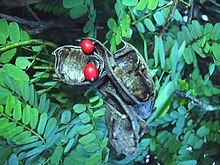2: 독미나리(Water Hemlock)
독미나리(cicuta maculata)는 매우 매혹적인 야생식물로 곧은 성장패턴을 보이고 보라색 줄무늬 잎과 하얀 꽃을 만발한다. 독미나리의 하얀색 뿌리는 가끔 파스닙(parsnip)식물과 착각하게 되는대 그것은 아주 치명적인 실수다. 독미나리에 함유된 독은 시큐톡신(cicutoxin)으로 식물 전체에 퍼저 있다. 하지만 대부분이 뿌리에 농축되어 있다. 누군가 독미나리의 뿌리를 파스닙과 혼동하여 한입 베어 먹으면 아주 고통스러운 죽음을 당하게 된다. 북아메리카가 원사지인 독미나리는 많은 사람들에게 그 대륙에서 가장 위험한 식물로 간주 된다, 1.8미터 까지 자라는 이 야생미나리는 개천 뚝이나 늪지대, 낮고 습한 저습지에서 번성한다.
The water hemlock, or cicuta maculata, is a very attractive wildflower with an upright growth pattern, purple-striped leaves and small white blooms. But the water hemlock's white roots are sometimes mistaken for a parsnip plant -- a potentially fatal error. The poison contained in the water hemlock, cicutoxin, is present in the entire plant, but is most concentrated in the roots. Anyone who confuses the plant with parsnips and decides to take a bite faces a violent death.The water hemlock, which is native to North America, is considered by many to be the most deadly plant on the continent. The wildflower, which grows to 6 feet (1.8 meters), thrives along stream banks, in marshy areas, and in low-lying, damp meadows.
운이 없게도 독미나리를 맛본 사람에게 고통의 시작은 매우 빨리 찾아온다. 이 식물의 시큐톡신(cicutoxin)은 격렬하고 고통스런 경련을 일으키고 어지러움증 구토 근육 떨림을 동반한다. 중독에서 살아남은 사람들은 치매 등 장기간의 건강 상태 악화를 경험해야한다. 어떠한 양의 독미나리 뿌리의 섭취도 안전하다고 생각할 수 없다. 그러므로 절대 먹어서는 안됀다!
For those unlucky enough to taste the water hemlock, the onset of illness is rapid. The cicutoxin contained in the plant causes violent and painful convulsions, nausea, vomiting, cramps and muscle tremors. Those who survive the poisoning experience long-term health conditions, such as amnesia. No amount of water hemlock root is considered safe to ingest.1: 협죽도(Oleander)
 (협죽도 꽃은 아름답지만 식물은 위험하다)
(협죽도 꽃은 아름답지만 식물은 위험하다)
협죽도(Nerium oleander)는 많은 사람들로 부터 전 세계에서 가장 독성이 강한 식물로 숙고된다, 아름다운 협죽도의 모든 부분에는 독이 있다. 독은 여러 종류로써 가장 독한 두가지는 올래안드린(oleandrin)과 네릴린(neriine)이다. 이 둘은 심장의 심각한 영향을 끼치는 것으로 유명하다. 협죽독의 독은 매우 강력하다. 실제로 협죽도의 꿀을 섭취한 꿀벌이 만든 꿀을 먹고 사람이 중독이 될 수 도 있다.
The oleander, or Nerium oleander, is considered by many to be the most poisonous plant in the world. All parts of the beautiful oleander contain poison -- several types of poison. Two of the most potent are oleandrin and neriine, known for their powerful effect on the heart. An oleander's poison is so strong, in fact, that it can poison a person who simply eats the honey made by bees that have digested oleander nectar.
협죽도는 아주 매혹적인 식물이다. 그래서 이러한 치명적인 평판에도 종종 장식용 식물로 쓰인다. 극동지역과 지중해가 원산지인 이 식물은 미국에도 소개되었다. 어디에서나 잘 자라며 비옥하지 않은 땅과 건조한 날씨에도 잘 견딘다. 이 식물은 밀집한 관목으로 자라며 보통 1.8~5.4미터 까지 큰다. 이 것은 두껍고 어두운 초록색 잎과 다발로 자라는 꽃을 가지고 있다. 꽃은 노란색, 빨간색, 핑크색 또는 하얀색이다.
The oleander is an attractive plant, and despite its deadly reputation is often planted for decorative purposes. Although native to the Far East and the Mediterranean areas, oleander has been introduced in the United States, where it grows easily. It's tolerant of poor quality soil and dry weather. The plant grows as a dense shrub, and is typically 6 to 18 feet (1.8 to 5.4 meters) tall at maturity. It has thick, dark green leaves, and the flowers, which grow in clusters, can be yellow, red, pink or white.
불모지에서도 협죽도는 아름다운 꽃과 향기를 생산한다. 동물들은 본능적으로 그 식물을 피한다. 협죽도는 매우 빨리 자라는대 그래서 고속도로의 방벽이나 소음과 공해를 막는 것을 필요로 하는 곳에 종종 사용된다. 빨리 자라는 성질 때문에 또한 새로운 공사현장에서 아주 인기있는 선택이다. 이것이 침식을 막아주기 때문이다.
Even in barren areas, the oleander produces lovely flowers and fragrance. Animals instinctively avoid the plant, and it grows rapidly, so it's often used for highway barriers and other areas that require screening from noise and pollution. Its rapid growth also makes it a popular choice around new construction zones, as it prevents erosion.
다른 독성 식물과 달리 협죽도는 인간을 포함한 대부분의 동물들에게 중독을 일으킨다. 나뭇잎 하나만 섭취헤도 아이가 죽을 수 있다. 협죽도를 먹으면 설사, 구토, 강렬한 복부통증, 졸음, 어지러움증, 불규칙한 심장박동, 그리고 종종 죽음과 같은 결과를 가져온다. 만약에 피해자가 식물을 섭취한 다음에 24시간 동안 살아남았다면 그 후에 살아남을 확률은 극적으로 매우 높아진다. 성공적인 치료를 위해서는 환자의 구토를 유발해야 하며 위를 세척하고 숯을 먹여 남아 있는 많은 양의 독소를 최대한 빼내야 한다.
Unlike some toxic plants, the oleander is poisonous to most animals as well as humans. A single ingested oleander leaf can kill a child. Ingestion of oleander results in diarrhea, vomiting, intense stomach pain, drowsiness, dizziness, an irregular heartbeat, and often, death. If the victim survives the initial 24 hours after ingestion, his or her odds of surviving increase dramatically. For successful treatment, the patient is induced to vomit, his or her stomach may be pumped, or he or she may be fed activated charcoal to absorb as much of the poison as possible.
